Maternal Hyperhomocysteinemia Produces Memory Deficits Associated with Impairment of Long-Term Synaptic Plasticity in Young Rats
Abstract
1. Introduction
2. Materials and Methods
2.1. Animals
2.2. Model of Maternal HCY
2.3. Electrophysology
2.3.1. Brain Slice Preparation
2.3.2. Field Excitatory Postsynaptic Potential (fEPSP) Recordings
2.3.3. Whole Cell Patch-Clamp Recordings
2.4. Reverse Transcription Followed by Quantitative Real-Time PCR (RT-qPCR)
2.5. Western Blot
2.6. Immunohistochemistry
2.7. Electron Microscopy
2.8. Behavioral Tests
2.8.1. Novel Object Recognition Test
2.8.2. Morris Water Maze Test
2.9. Statistical Analysis
3. Results
3.1. Maternal HCY Impair Non-Spatial Memory in NOR Test
3.2. Maternal HCY Impair Learning and Spatial Memory in Morris Water Maze
3.3. Maternal HCY Impair Long-Term Synaptic Plasticity in the Rat Hippocampus
3.4. Maternal HCY Affects the Properties of NMDAR-Mediated Currents in CA1
3.5. Effects of HCY on Expression of Ionotropic Glutamate Receptor Subunits
3.6. The Number of Synaptopodin-Positive Dendritic Spines Decreased in the Hippocampus Following Prenatal HCY
3.7. Ultrastructure of the CA1 Hippocampus Tissue
4. Discussion
Author Contributions
Funding
Institutional Review Board Statement
Informed Consent Statement
Data Availability Statement
Acknowledgments
Conflicts of Interest
Appendix A
| Gene Symbol RefSeq Accession Number | Primer 5’–3’ (Forward, Reverse, Probe) | Final Concentrations, nM | References |
|---|---|---|---|
| Actb NM_031144 | TGTCACCAACTGGGACGATA GGGGTGTTGAAGGTCTCAAA FAM-CGTGTGGCCCCTGAGGAGCAC-BHQ1 | 200 200 | [70] (primers) [26] (probe) |
| Gapdh NM_017008 | TGCACCACCAACTGCTTAG GGATGCAGGGATGATGTTC R6G-ATCACGCCACAGCTTTCCAGAGGG-BHQ2 | 200 100 | [71] |
| B2m NM_012512 | TGCCATTCAGAAAACTCCCC GAGGAAGTTGGGCTTCCCATT ROX-ATTCAAGTGTACTCTCGCCATCCACCG-BHQ1 | 200 100 | [72] |
| Rpl13a NM_173340 | GGATCCCTCCACCCTATGACA CTGGTACTTCCACCCGACCTC FAM-CTGCCCTCAAGGTTGTGCGGCT-BHQ1 | 200 100 | [73] (primers) [26] (probe) |
| Sdha NM_130428 | AGACGTTTGACAGGGGAATG TCATCAATCCGCACCTTGTA R6G-ACCTGGTGGAGACGCTGGAGCT-BHQ2 | 200 100 | [74] (primers) [26] (probe) |
| Ppia NM_017101 | AGGATTCATGTGCCAGGGTG CTCAGTCTTGGCAGTGCAGA ROX-CACGCCATAATGGCACTGGTGGCA-BHQ1 | 200 100 | [75] |
| Hprt1 NM_012583 | TCCTCAGACCGCTTTTCCCGC TCATCATCACTAATCACGACGCTGG FAM-CCGACCGGTTCTGTCATGTCGACCCT-BHQ1 | 200 100 | [76] (primers) [26] (probe) |
| Pgk1 NM_053291 | ATGCAAAGACTGGCCAAGCTAC AGCCACAGCCTCAGCATATTTC R6G-TGCTGGCTGGATGGGCTTGGA-BHQ2 | 200 100 | [77] (primers) [26] (probe) |
| Ywhaz NM_013011 | GATGAAGCCATTGCTGAACTTG GTCTCCTTGGGTATCCGATGTC ROX-TGAAGAGTCGTACAAAGACAGCACGC-BHQ1 | 200 100 | [77] (primers) [26] (probe) |
| Grin1 NM_017010 | GTTCTTCCGCTCAGGCTTTG AGGGAAACGTTCTGCTTCCA FAM-CGGCATGCGCAAGGACAGCC-BHQ1 | 200 100 | [78] |
| Grin2a NM_012573 | GCTACACACCCTGCACCAATT CACCTGGTAACCTTCCTCAGTGA FAM-TGGTCAATGTGACTTGGGATGGCAA-BHQ1 | 200 100 | [79] |
| Grin2b NM_012574 | CCCAACATGCTCTCTCCCTTAA CAGCTAGTCGGCTCTCTTGGTT FAM-GACGCCAAACCTCTAGGCGGACAG-BHQ1 | 200 100 | [79] |
| Gria1 NM_031608 | TCAGAACGCCTCAACGCC TGTAGTGGTACCCGATGCCA ROX-TCCTGGGCCAGATCGTGAAGCTAGAAAA-BHQ1 | 200 100 | [80] |
| Gria2 NM_017261 | CAGTGCATTTCGGGTAGGGA TGCGAAACTGTTGGCTACCT FAM-TCGGAGTTCAGACTGACACCCCA-BHQ1 | 200 100 | [80] |
Appendix B
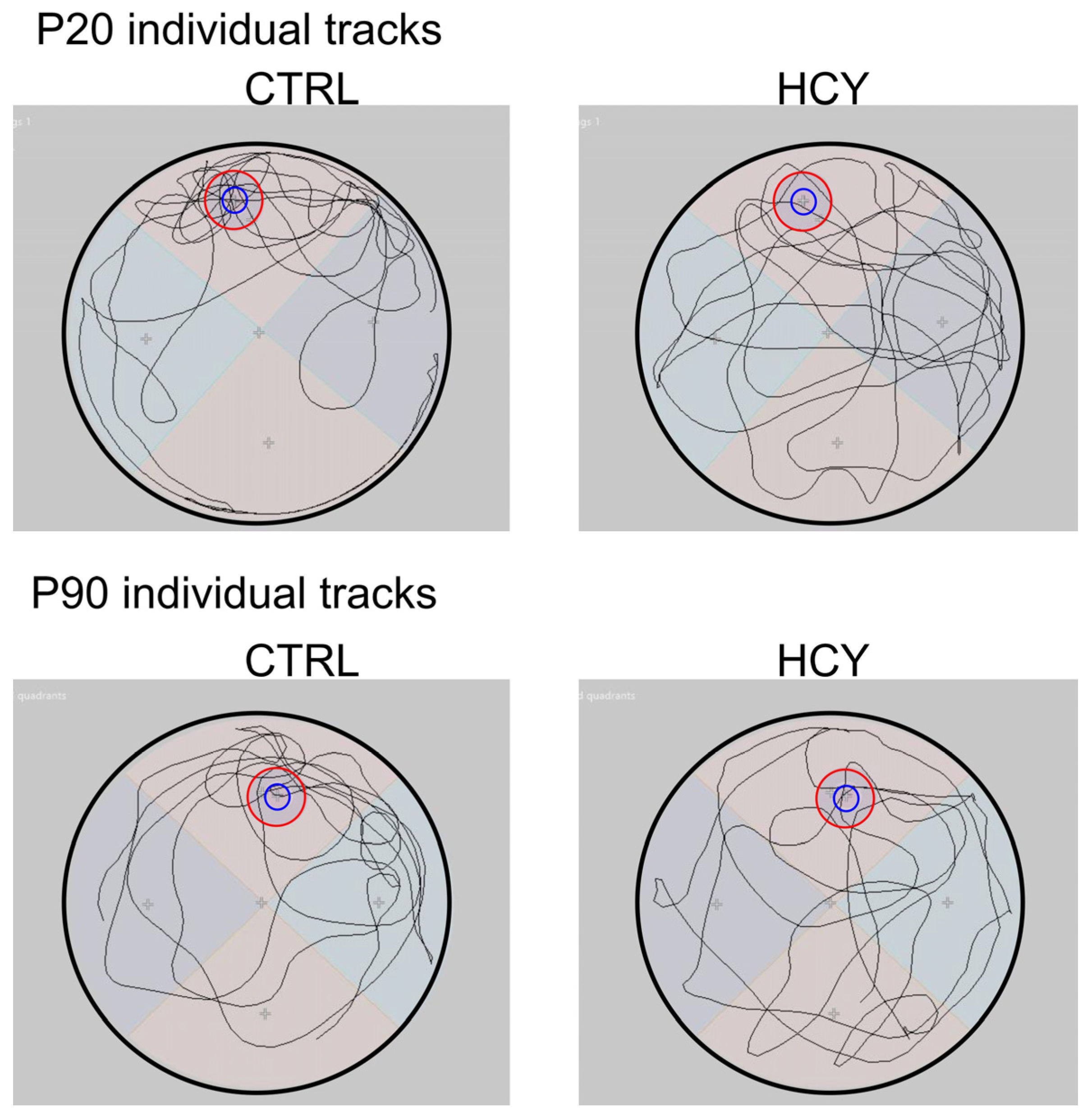
References
- Desplats, P.A. Perinatal Programming of Neurodevelopment: Epigenetic Mechanisms and the Prenatal Shaping of the Brain. Adv. Neurobiol. 2015, 10, 335–361. [Google Scholar] [CrossRef] [PubMed]
- Babenko, O.; Kovalchuk, I.; Metz, G.A.S. Stress-Induced Perinatal and Transgenerational Epigenetic Programming of Brain Development and Mental Health. Neurosci. Biobehav. Rev. 2015, 48, 70–91. [Google Scholar] [CrossRef] [PubMed]
- Barradas, P.C.; Savignon, T.; Manhães, A.C.; Tenório, F.; da Costa, A.P.; Cunha-Rodrigues, M.C.; Vaillant, J. Prenatal Systemic Hypoxia-Ischemia and Oligodendroglia Loss in Cerebellum. Adv. Exp. Med. Biol. 2016, 949, 333–345. [Google Scholar] [CrossRef]
- Nalivaeva, N.N.; Turner, A.J.; Zhuravin, I.A. Role of Prenatal Hypoxia in Brain Development, Cognitive Functions, and Neurodegeneration. Front. Neurosci. 2018, 12, 825. [Google Scholar] [CrossRef]
- Milyutina, Y.P.; Shcherbitskaia, A.D.; Zalozniaia, I.V.; Kerkeshko, G.O.; Arutjunyan, A.V. Neurotrophic Factors and Inflammatory Cytokines in the Mother-Placenta-Fetus System in Experimental Hyperhomocysteinemia. Med. Acad. J. 2019, 19, 230–231. [Google Scholar] [CrossRef]
- Gerasimova, E.; Yakovleva, O.; Burkhanova, G.; Ziyatdinova, G.; Khaertdinov, N.; Sitdikova, G. Effects of Maternal Hyperhomocysteinemia on the Early Physical Development and Neurobehavioral Maturation of Rat Offspring. Bionanoscience 2017, 7, 155–158. [Google Scholar] [CrossRef]
- Kurmashova, E.D.; Gataulina, E.D.; Zefirov, A.L.; Sitdikova, G.F.; Yakovlev, A.V. Effects of Homocysteine and Its Derivatives on Spontaneous Network Activity in the Hippocampus of Neonatal Rat Pups. Neurosci. Behav. Physiol. 2020, 50, 907–913. [Google Scholar] [CrossRef]
- Yakovlev, A.V.; Kurmashova, E.; Zakharov, A.; Sitdikova, G.F. Network-Driven Activity and Neuronal Excitability in Hippocampus of Neonatal Rats with Prenatal Hyperhomocysteinemia. Bionanoscience 2018, 8, 304–309. [Google Scholar] [CrossRef]
- Kumar, M.; Modi, M.; Sandhir, R. Hydrogen Sulfide Attenuates Homocysteine-Induced Cognitive Deficits and Neurochemical Alterations by Improving Endogenous Hydrogen Sulfide Levels. BioFactors 2017, 43, 434–450. [Google Scholar] [CrossRef]
- Gao, L.; Zeng, X.N.; Guo, H.M.; Wu, X.M.; Chen, H.J.; Di, R.K.; Wu, Y. Cognitive and Neurochemical Alterations in Hyperhomocysteinemic Rat. Neurol. Sci. 2012, 33, 39–43. [Google Scholar] [CrossRef]
- Jadavji, N.M.; Deng, L.; Malysheva, O.; Caudill, M.A.; Rozen, R. MTHFR Deficiency or Reduced Intake of Folate or Choline in Pregnant Mice Results in Impaired Short-Term Memory and Increased Apoptosis in the Hippocampus of Wild-Type Offspring. Neuroscience 2015, 300, 1–9. [Google Scholar] [CrossRef] [PubMed]
- Shcherbitskaia, A.D.; Vasilev, D.S.; Milyutina, Y.P.; Tumanova, N.L.; Mikhel, A.V.; Zalozniaia, I.V.; Arutjunyan, A.V. Prenatal Hyperhomocysteinemia Induces Glial Activation and Alters Neuroinflammatory Marker Expression in Infant Rat Hippocampus. Cells 2021, 10, 1536. [Google Scholar] [CrossRef] [PubMed]
- Shcherbitskaia, A.D.; Vasilev, D.S.; Milyutina, Y.P.; Tumanova, N.L.; Zalozniaia, I.V.; Kerkeshko, G.O.; Arutjunyan, A.V. Maternal Hyperhomocysteinemia Induces Neuroinflammation and Neuronal Death in the Rat Offspring Cortex. Neurotox. Res. 2020, 38, 408–420. [Google Scholar] [CrossRef] [PubMed]
- Baydas, G.; Koz, S.T.; Tuzcu, M.; Nedzvetsky, V.S. Melatonin Prevents Gestational Hyperhomocysteinemia-Associated Alterations in Neurobehavioral Developments in Rats. J. Pineal Res. 2008, 44, 181–188. [Google Scholar] [CrossRef] [PubMed]
- Bonetti, F.; Brombo, G.; Zuliani, G. The Relationship between Hyperhomocysteinemia and Neurodegeneration. Neurodegener. Dis. Manag. 2016, 6, 133–145. [Google Scholar] [CrossRef]
- Opitz, B. Memory Function and the Hippocampus. Front. Neurol. Neurosci. 2014, 34, 51–59. [Google Scholar] [CrossRef]
- Milner, B.; Squire, L.R.; Kandel, E.R. Cognitive Neuroscience and the Study of Memory. Neuron 1998, 20, 445–468. [Google Scholar] [CrossRef]
- Collingridge, G.L.; Isaac, J.T.R.; Yu, T.W. Receptor Trafficking and Synaptic Plasticity. Nat. Rev. Neurosci. 2004, 5, 952–962. [Google Scholar] [CrossRef]
- Kim, J.J.; Diamond, D.M. The Stressed Hippocampus, Synaptic Plasticity and Lost Memories. Nat. Rev. Neurosci. 2002, 3, 453–462. [Google Scholar] [CrossRef]
- Arutjunyan, A.V.; Milyutina, Y.P.; Shcherbitskaia, A.D.; Kerkeshko, G.O.; Zalozniaia, I.V.; Mikhel, A.V. Neurotrophins of the Fetal Brain and Placenta in Prenatal Hyperhomocysteinemia. Biochemistry 2020, 85, 213–223. [Google Scholar] [CrossRef]
- Arutyunyan, A.V.; Milyutina, Y.P.; Zaloznyaya, I.V.; Pustygina, A.V.; Kozina, L.S.; Korenevskii, A.V. The Use of Different Experimental Models of Hyperhomocysteinemia in Neurochemical Studies. Neurochem. J. 2012, 6, 71–76. [Google Scholar] [CrossRef]
- Spencer, J.L.; Waters, E.M.; Romeo, R.D.; Wood, G.E.; Milner, T.A.; McEwen, B.S. Uncovering the Mechanisms of Estrogen Effects on Hippocampal Function. Front. Neuroendocrinol. 2008, 29, 219–237. [Google Scholar] [CrossRef] [PubMed]
- Postnikova, T.Y.; Diespirov, G.P.; Amakhin, D.V.; Vylekzhanina, E.N.; Soboleva, E.B.; Zaitsev, A.V. Impairments of Long-Term Synaptic Plasticity in the Hippocampus of Young Rats during the Latent Phase of the Lithium-Pilocarpine Model of Temporal Lobe Epilepsy. Int. J. Mol. Sci. 2021, 22, 13355. [Google Scholar] [CrossRef] [PubMed]
- Zubareva, O.E.; Postnikova, T.Y.; Grifluk, A.V.; Schwarz, A.P.; Smolensky, I.V.; Karepanov, A.A.; Vasilev, D.S.; Veniaminova, E.A.; Rotov, A.Y.; Kalemenev, S.V.; et al. Exposure to Bacterial Lipopolysaccharide in Early Life Affects the Expression of Ionotropic Glutamate Receptor Genes and Is Accompanied by Disturbances in Long-Term Potentiation and Cognitive Functions in Young Rats. Brain. Behav. Immun. 2020, 90, 3–15. [Google Scholar] [CrossRef]
- Paxinos, G.; Watson, C. The Rat Brain in Stereotaxic Coordinates; Elsevier: Amsterdam, The Netherlands, 2007. [Google Scholar]
- Schwarz, A.P.; Malygina, D.A.; Kovalenko, A.A.; Trofimov, A.N.; Zaitsev, A.V. Multiplex QPCR Assay for Assessment of Reference Gene Expression Stability in Rat Tissues/Samples. Mol. Cell. Probes 2020, 53, 101611. [Google Scholar] [CrossRef]
- Livak, K.J.; Schmittgen, T.D. Analysis of Relative Gene Expression Data Using Real-Time Quantitative PCR and the 2−ΔΔCT Method. Methods 2001, 25, 402–408. [Google Scholar] [CrossRef]
- Zhuravin, I.A.; Dubrovskaya, N.M.; Vasilev, D.S.; Postnikova, T.Y.; Zaitsev, A.V. Prenatal Hypoxia Produces Memory Deficits Associated with Impairment of Long-Term Synaptic Plasticity in Young Rats. Neurobiol. Learn. Mem. 2019, 164, 107066. [Google Scholar] [CrossRef]
- Bradford, M.M. A Rapid and Sensitive Method for the Quantitation of Microgram Quantities of Protein Utilizing the Principle of Protein-Dye Binding. Anal. Biochem. 1976, 72, 248–254. [Google Scholar] [CrossRef]
- Deller, T.; Merten, T.; Roth, S.U.; Mundel, P.; Frotscher, M. Actin-Associated Protein Synaptopodin in the Rat Hippocampal Formation: Localization in the Spine Neck and Close Association with the Spine Apparatus of Principal Neurons. J. Comp. Neurol. 2000, 418, 164–181. [Google Scholar] [CrossRef]
- Okubo-Suzuki, R.; Okada, D.; Sekiguchi, M.; Inokuchi, K. Synaptopodin Maintains the Neural Activity-Dependent Enlargement of Dendritic Spines in Hippocampal Neurons. Mol. Cell. Neurosci. 2008, 38, 266–276. [Google Scholar] [CrossRef]
- Vasilev, D.S.; Tumanova, N.L.; Kim, K.K.; Lavrentyeva, V.V.; Lukomskaya, N.Y.; Zhuravin, I.A.; Magazanik, L.G.; Zaitsev, A.V. Transient Morphological Alterations in the Hippocampus After Pentylenetetrazole-Induced Seizures in Rats. Neurochem. Res. 2018, 43, 1671–1682. [Google Scholar] [CrossRef] [PubMed]
- Cohen, S.J.; Stackman, R.W., Jr. Assessing Rodent Hippocampal Involvement in the Novel Object Recognition Task. A Review. Behav. Brain Res. 2015, 285, 105–117. [Google Scholar] [CrossRef] [PubMed]
- Lissner, L.J.; Wartchow, K.M.; Toniazzo, A.P.; Gonçalves, C.-A.; Rodrigues, L. Object Recognition and Morris Water Maze to Detect Cognitive Impairment from Mild Hippocampal Damage in Rats: A Reflection Based on the Literature and Experience. Pharmacol. Biochem. Behav. 2021, 210, 173273. [Google Scholar] [CrossRef] [PubMed]
- Chernyuk, D.P.; Bol’shakova, A.V.; Vlasova, O.L.; Bezprozvanny, I.B. Possibilities and Prospects of the Behavioral Test “Morris Water Maze”. J. Evol. Biochem. Physiol. 2021, 57, 289–303. [Google Scholar] [CrossRef]
- Wang, D.; Noda, Y.; Zhou, Y.; Mouri, A.; Mizoguchi, H.; Nitta, A.; Chen, W.; Nabeshima, T. The Allosteric Potentiation of Nicotinic Acetylcholine Receptors by Galantamine Ameliorates the Cognitive Dysfunction in Beta Amyloid25–35 I.c.v.-Injected Mice: Involvement of Dopaminergic Systems. Neuropsychopharmacology 2007, 32, 1261–1271. [Google Scholar] [CrossRef]
- Sadaghiani, M.M.; Saboory, E. Prenatal Stress Potentiates Pilocarpine-Induced Epileptic Behaviors in Infant Rats Both Time and Sex Dependently. Epilepsy Behav. 2010, 18, 166–170. [Google Scholar] [CrossRef]
- Spear, L.P. Adolescent Neurodevelopment. J. Adolesc. Health 2013, 52, S7–S13. [Google Scholar] [CrossRef]
- Dubrovskaya, N.M.; Zhuravin, I.A. Ontogenetic Characteristics of Behavior in Rats Subjected to Hypoxia on Day 14 or Day 18 of Embryogenesis. Neurosci. Behav. Physiol. 2010, 40, 231–238. [Google Scholar] [CrossRef]
- Bliss, T.V.P.; Collingridge, G.L. A Synaptic Model of Memory: Long-Term Potentiation in the Hippocampus. Nature 1993, 361, 31–39. [Google Scholar] [CrossRef]
- Deller, T.; Korte, M.; Chabanis, S.; Drakew, A.; Schwegler, H.; Stefani, G.G.; Zuniga, A.; Schwarz, K.; Bonhoeffer, T.; Zeller, R.; et al. Synaptopodin-Deficient Mice Lack a Spine Apparatus and Show Deficits in Synaptic Plasticity. Proc. Natl. Acad. Sci. USA 2003, 100, 10494–10499. [Google Scholar] [CrossRef]
- Martin, K.C.; Barad, M.; Kandel, E.R. Local Protein Synthesis and Its Role in Synapse-Specific Plasticity. Curr. Opin. Neurobiol. 2000, 10, 587–592. [Google Scholar] [CrossRef] [PubMed]
- Zito, K.; Scheuss, V.; Knott, G.; Hill, T.; Svoboda, K. Rapid Functional Maturation of Nascent Dendritic Spines. Neuron 2009, 61, 247–258. [Google Scholar] [CrossRef] [PubMed]
- Zhang, X.-l.; Poschel, B.; Faul, C.; Upreti, C.; Stanton, P.K.; Mundel, P. Essential Role for Synaptopodin in Dendritic Spine Plasticity of the Developing Hippocampus. J. Neurosci. 2013, 33, 12510–12518. [Google Scholar] [CrossRef] [PubMed]
- Baydas, G.; Koz, S.T.; Tuzcu, M.; Nedzvetsky, V.S.; Etem, E. Effects of Maternal Hyperhomocysteinemia Induced by High Methionine Diet on the Learning and Memory Performance in Offspring. Int. J. Dev. Neurosci. 2007, 25, 133–139. [Google Scholar] [CrossRef]
- Koz, S.T.; Baydas, G.; Koz, S.; Demir, N.; Nedzvetsky, V.S. Gingko Biloba Extract Inhibits Oxidative Stress and Ameliorates Impaired Glial Fibrillary Acidic Protein Expression, but Can Not Improve Spatial Learning in Offspring from Hyperhomocysteinemic Rat Dams. Phyther. Res. 2012, 26, 949–955. [Google Scholar] [CrossRef]
- Shcherbitskaya, A.D.; Milyutina, Y.P.; Zaloznyaya, I.V.; Arutjunyan, A.V.; Nalivaeva, N.N.; Zhuravin, I.A. The Effects of Prenatal Hyperhomocysteinemia on the Formation of Memory and the Contents of Biogenic Amines in the Rat Hippocampus. Neurochem. J. 2017, 11, 296–301. [Google Scholar] [CrossRef]
- Arutjunyan, A.; Kozina, L.; Stvolinskiy, S.; Bulygina, Y.; Mashkina, A.; Khavinson, V. Pinealon Protects the Rat Offspring from Prenatal Hyperhomocysteinemia. Int. J. Clin. Exp. Med. 2012, 5, 179–185. [Google Scholar]
- Silvers, J.M.; Harrod, S.B.; Mactutus, C.F.; Booze, R.M. Automation of the Novel Object Recognition Task for Use in Adolescent Rats. J. Neurosci. Methods 2007, 166, 99–103. [Google Scholar] [CrossRef]
- Cai, Z.; Rhodes, P.G. Intrauterine Hypoxia-Ischemia Alters Expression of the NMDA Receptor in the Young Rat Brain. Neurochem. Res. 2001, 26, 487–495. [Google Scholar] [CrossRef]
- Neeley, E.W.; Berger, R.; Koenig, J.I.; Leonard, S. Strain Dependent Effects of Prenatal Stress on Gene Expression in the Rat Hippocampus. Physiol. Behav. 2011, 104, 334–339. [Google Scholar] [CrossRef]
- Yokota, S.; Sato, A.; Umezawa, M.; Oshio, S.; Takeda, K. In Utero Exposure of Mice to Diesel Exhaust Particles Affects Spatial Learning and Memory with Reduced N-Methyl-d-Aspartate Receptor Expression in the Hippocampus of Male Offspring. Neurotoxicology 2015, 50, 108–115. [Google Scholar] [CrossRef] [PubMed]
- Ehsanifar, M.; Jafari, A.J.; Nikzad, H.; Zavareh, M.S.; Atlasi, M.A.; Mohammadi, H.; Tameh, A.A. Prenatal Exposure to Diesel Exhaust Particles Causes Anxiety, Spatial Memory Disorders with Alters Expression of Hippocampal pro-Inflammatory Cytokines and NMDA Receptor Subunits in Adult Male Mice Offspring. Ecotoxicol. Environ. Saf. 2019, 176, 34–41. [Google Scholar] [CrossRef] [PubMed]
- Yao, D.; Mu, Y.; Lu, Y.; Li, L.; Shao, S.; Zhou, J.; Li, J.; Chen, S.; Zhang, D.; Zhang, Y.; et al. Hippocampal AMPA Receptors Mediate the Impairment of Spatial Learning and Memory in Prenatally Stressed Offspring Rats. J. Psychiatr. Res. 2022, 151, 17–24. [Google Scholar] [CrossRef]
- Ho, P.I.; Ortiz, D.; Rogers, E.; Shea, T.B. Multiple Aspects of Homocysteine Neurotoxicity: Glutamate Excitotoxicity, Kinase Hyperactivation and DNA Damage. J. Neurosci. Res. 2002, 70, 694–702. [Google Scholar] [CrossRef] [PubMed]
- Deep, S.N.; Mitra, S.; Rajagopal, S.; Paul, S.; Poddar, R. GluN2A-NMDA Receptor-Mediated Sustained Ca(2+) Influx Leads to Homocysteine-Induced Neuronal Cell Death. J. Biol. Chem. 2019, 294, 11154–11165. [Google Scholar] [CrossRef]
- Hansen, K.B.; Yi, F.; Perszyk, R.E.; Furukawa, H.; Wollmuth, L.P.; Gibb, A.J.; Traynelis, S.F. Structure, Function, and Allosteric Modulation of NMDA Receptors. J. Gen. Physiol. 2018, 150, 1081–1105. [Google Scholar] [CrossRef] [PubMed]
- Eichelbaum, K.; Krijgsveld, J. Rapid Temporal Dynamics of Transcription, Protein Synthesis, and Secretion during Macrophage Activation. Mol. Cell. Proteom. 2014, 13, 792–810. [Google Scholar] [CrossRef]
- Jovanovic, M.; Rooney, M.S.; Mertins, P.; Przybylski, D.; Chevrier, N.; Satija, R.; Rodriguez, E.H.; Fields, A.P.; Schwartz, S.; Raychowdhury, R.; et al. Dynamic Profiling of the Protein Life Cycle in Response to Pathogens. Science 2015, 347, 1259038. [Google Scholar] [CrossRef]
- Zhang, S.; Wang, X.; Ai, S.; Ouyang, W.; Le, Y.; Tong, J. Sepsis-Induced Selective Loss of NMDA Receptors Modulates Hippocampal Neuropathology in Surviving Septic Mice. PLoS ONE 2017, 12, e0188273. [Google Scholar] [CrossRef]
- Kovalenko, A.A.; Zakharova, M.V.; Zubareva, O.E.; Schwarz, A.P.; Postnikova, T.Y.; Zaitsev, A.V. Alterations in MRNA and Protein Expression of Glutamate Receptor Subunits Following Pentylenetetrazole-Induced Acute Seizures in Young Rats. Neuroscience 2021, 468, 1–15. [Google Scholar] [CrossRef]
- Turecek, R.; Vyklický, L.; Vlachová, V.; Vyklický, L.J. G-Protein Modulation of Glycine-Resistant NMDA Receptor Desensitization in Rat Cultured Hippocampal Neurons. Eur. J. Neurosci. 1995, 7, 1826–1830. [Google Scholar] [CrossRef] [PubMed]
- Sibarov, D.A.; Antonov, S.M. Calcium-Dependent Desensitization of NMDA Receptors. Biochemistry 2018, 83, 1173–1183. [Google Scholar] [CrossRef] [PubMed]
- Tong, G.; Jahr, C.E. Regulation of Glycine-Insensitive Desensitization of the NMDA Receptor in Outside-out Patches. J. Neurophysiol. 1994, 72, 754–761. [Google Scholar] [CrossRef]
- Chen, N.; Moshaver, A.; Raymond, L.A. Differential Sensitivity of Recombinant N-Methyl-D-Aspartate Receptor Subtypes to Zinc Inhibition. Mol. Pharmacol. 1997, 51, 1015–1023. [Google Scholar] [CrossRef] [PubMed]
- Cummings, K.A.; Popescu, G.K. Glycine-Dependent Activation of NMDA Receptors. J. Gen. Physiol. 2015, 145, 513–527. [Google Scholar] [CrossRef]
- Li, B.; Otsu, Y.; Murphy, T.H.; Raymond, L.A. Developmental Decrease in NMDA Receptor Desensitization Associated with Shift to Synapse and Interaction with Postsynaptic Density-95. J. Neurosci. 2003, 23, 11244–11254. [Google Scholar] [CrossRef]
- Bolton, A.D.; Phillips, M.A.; Constantine-Paton, M. Homocysteine Reduces NMDAR Desensitization and Differentially Modulates Peak Amplitude of NMDAR Currents, Depending on GluN2 Subunit Composition. J. Neurophysiol. 2013, 110, 1567–1582. [Google Scholar] [CrossRef]
- Vlachos, A.; Korkotian, E.; Schonfeld, E.; Copanaki, E.; Deller, T.; Segal, M. Synaptopodin Regulates Plasticity of Dendritic Spines in Hippocampal Neurons. J. Neurosci. 2009, 29, 1017–1033. [Google Scholar] [CrossRef]
- Bonefeld, B.E.; Elfving, B.; Wegener, G. Reference Genes for Normalization: A Study of Rat Brain Tissue. Synapse 2008, 62, 302–309. [Google Scholar] [CrossRef]
- Lin, W.; Burks, C.A.; Hansen, D.R.; Kinnamon, S.C.; Gilbertson, T.A. Taste Receptor Cells Express PH-Sensitive Leak K+ Channels. J. Neurophysiol. 2004, 92, 2909–2919. [Google Scholar] [CrossRef]
- Yamaguchi, M.; Yamauchi, A.; Nishimura, M.; Ueda, N.; Naito, S. Soybean Oil Fat Emulsion Prevents Cytochrome P450 MRNA Down-Regulation Induced by Fat-Free Overdose Total Parenteral Nutrition in Infant Rats. Biol. Pharm. Bull. 2005, 28, 143–147. [Google Scholar] [CrossRef] [PubMed]
- Swijsen, A.; Nelissen, K.; Janssen, D.; Rigo, J.M.; Hoogland, G. Validation of Reference Genes for Quantitative Real-Time PCR Studies in the Dentate Gyrus after Experimental Febrile Seizures. BMC Res. Notes 2012, 5, 685. [Google Scholar] [CrossRef] [PubMed]
- Pohjanvirta, R.; Niittynen, M.; Lindén, J.; Boutros, P.C.; Moffat, I.D.; Okey, A.B. Evaluation of Various Housekeeping Genes for Their Applicability for Normalization of MRNA Expression in Dioxin-Treated Rats. Chem. Biol. Interact. 2006, 160, 134–149. [Google Scholar] [CrossRef] [PubMed]
- Malkin, S.L.; Amakhin, D.V.; Veniaminova, E.A.; Kim, K.K.; Zubareva, O.E.; Magazanik, L.G.; Zaitsev, A.V. Changes of AMPA Receptor Properties in the Neocortex and Hippocampus Following Pilocarpine-Induced Status Epilepticus in Rats. Neuroscience 2016, 327, 146–155. [Google Scholar] [CrossRef] [PubMed]
- Cook, N.L.; Vink, R.; Donkin, J.J.; van den Heuvel, C. Validation of Reference Genes for Normalization of Real-Time Quantitative RT-PCR Data in Traumatic Brain Injury. J. Neurosci. Res. 2009, 87, 34–41. [Google Scholar] [CrossRef]
- Langnaese, K.; John, R.; Schweizer, H.; Ebmeyer, U.; Keilhoff, G. Selection of Reference Genes for Quantitative Real-Time PCR in a Rat Asphyxial Cardiac Arrest Model. BMC Mol. Biol. 2008, 9, 53. [Google Scholar] [CrossRef]
- Giza, C.C.; Maria, N.S.S.; Hovda, D.A. N-Methyl-D-Aspartate Receptor Subunit Changes after Traumatic Injury to the Developing Brain. J. Neurotrauma 2006, 23, 950–961. [Google Scholar] [CrossRef]
- Floyd, D.W.; Jung, K.-Y.; McCool, B.A. Chronic Ethanol Ingestion Facilitates N-Methyl-D-Aspartate Receptor Function and Expression in Rat Lateral/Basolateral Amygdala Neurons. J. Pharmacol. Exp. Ther. 2003, 307, 1020–1029. [Google Scholar] [CrossRef]
- Proudnikov, D.; Yuferov, V.; Zhou, Y.; LaForge, K.S.; Ho, A.; Kreek, M.J. Optimizing Primer—Probe Design for Fluorescent PCR. J. Neurosci. Methods 2003, 123, 31–45. [Google Scholar] [CrossRef]
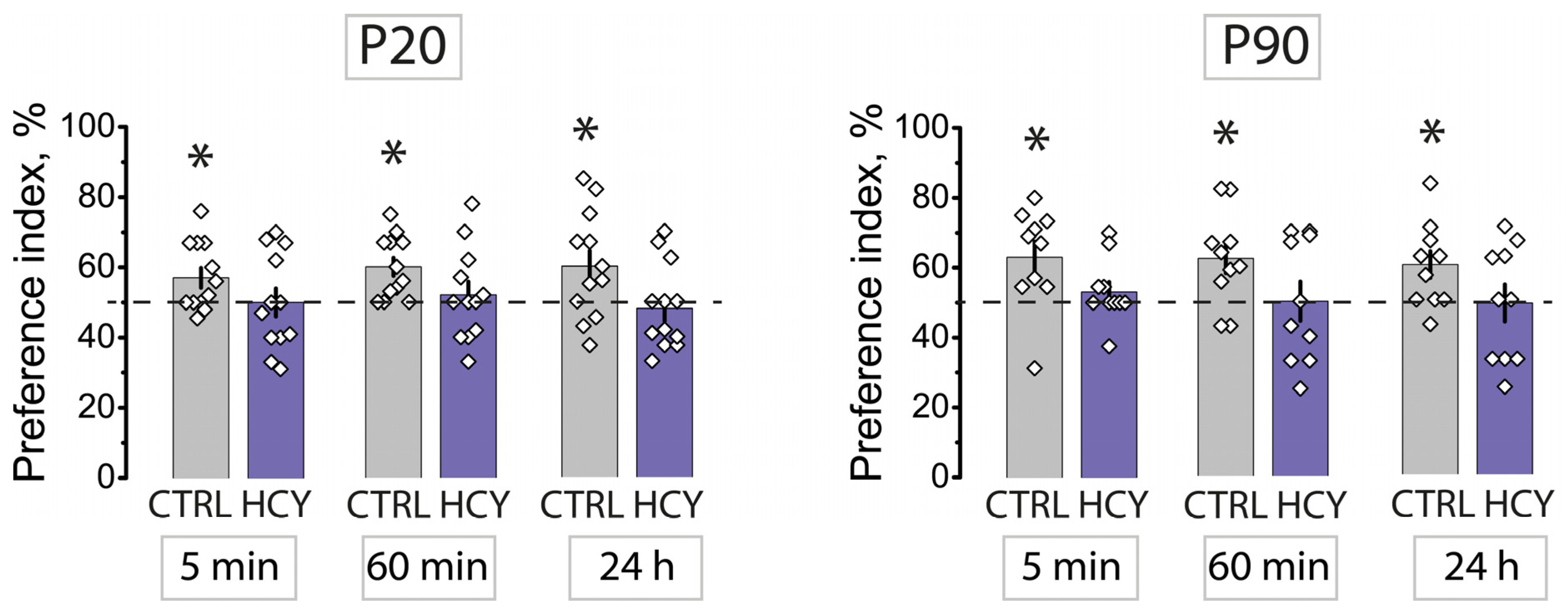
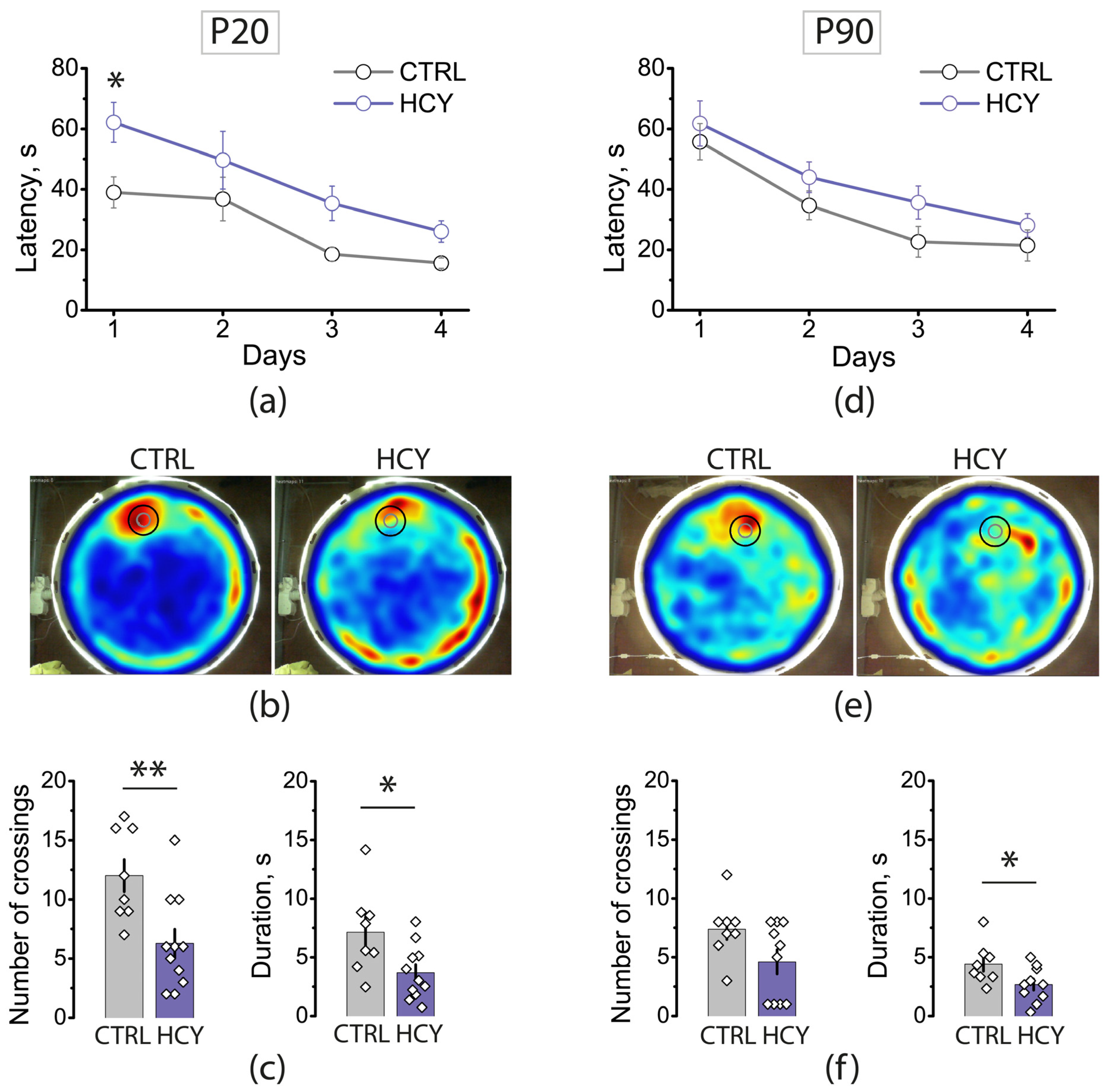
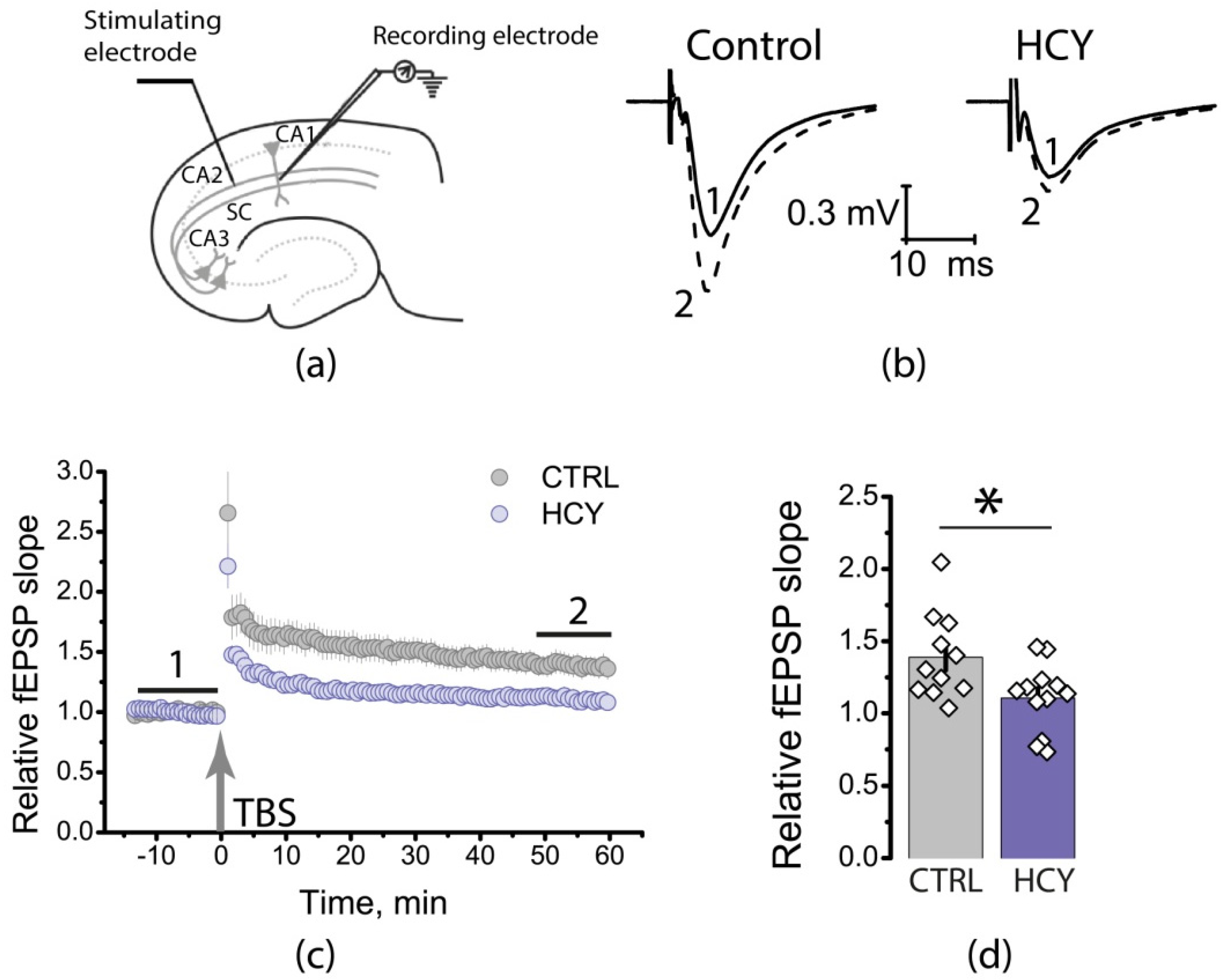

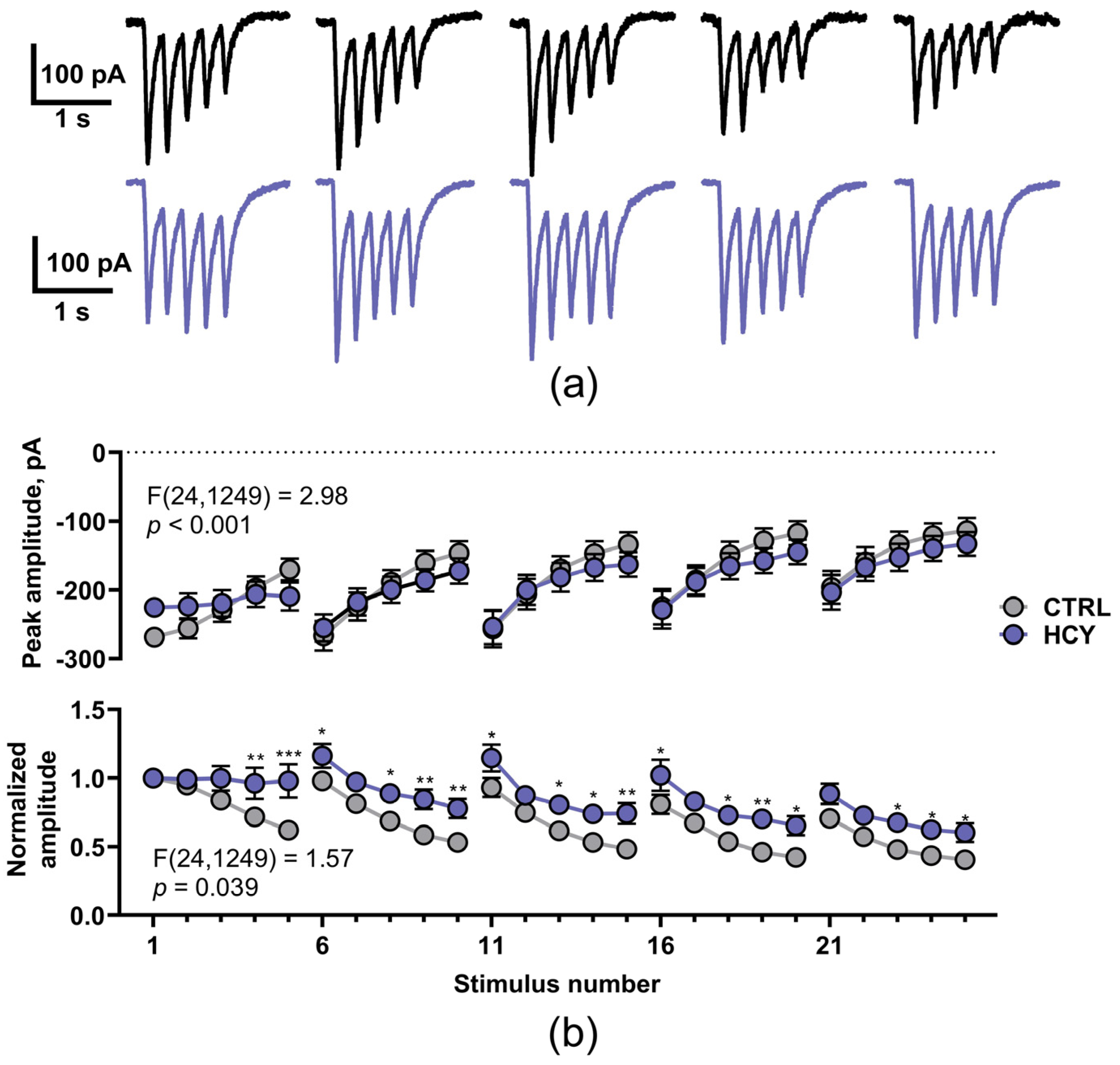
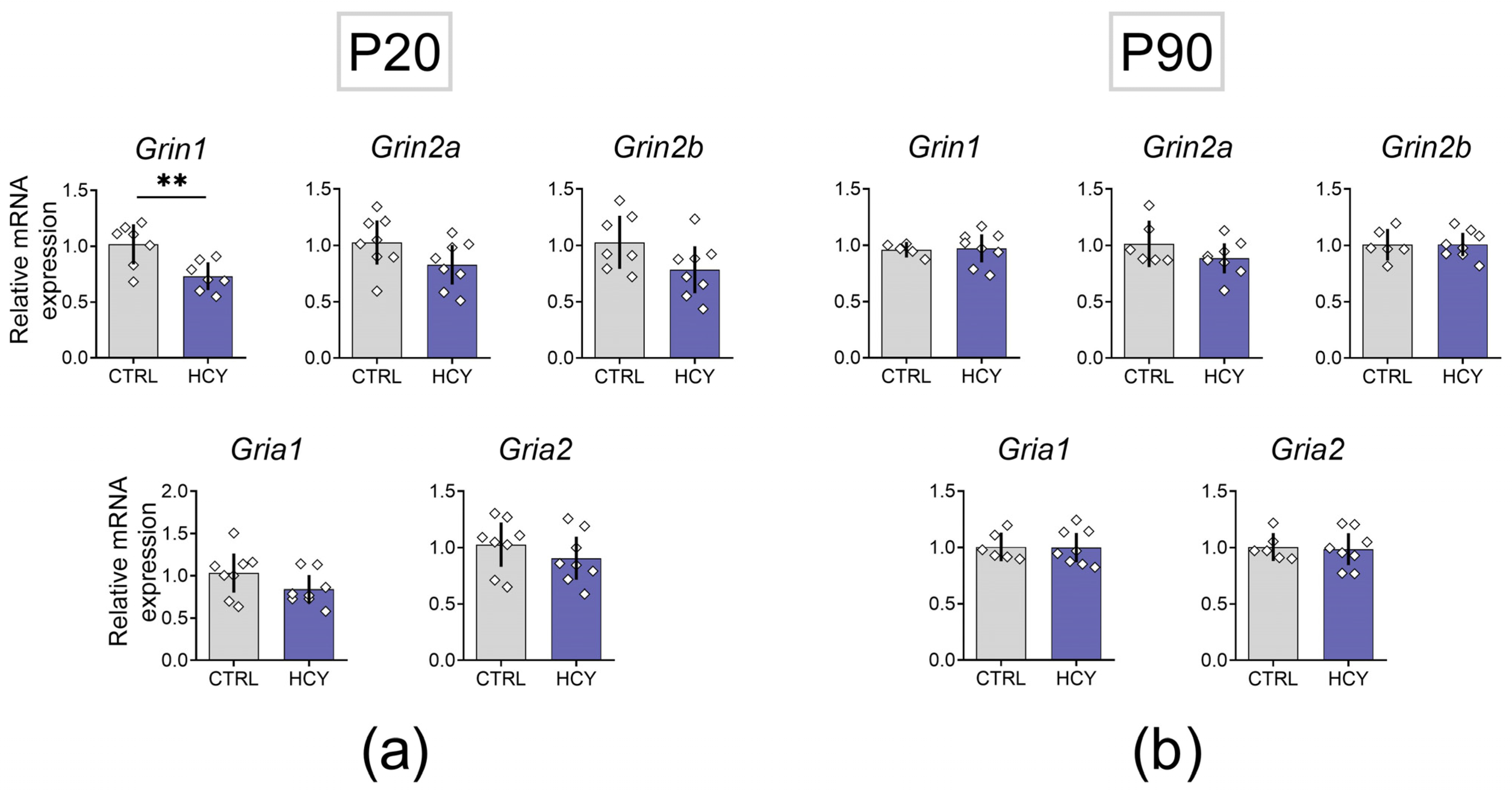
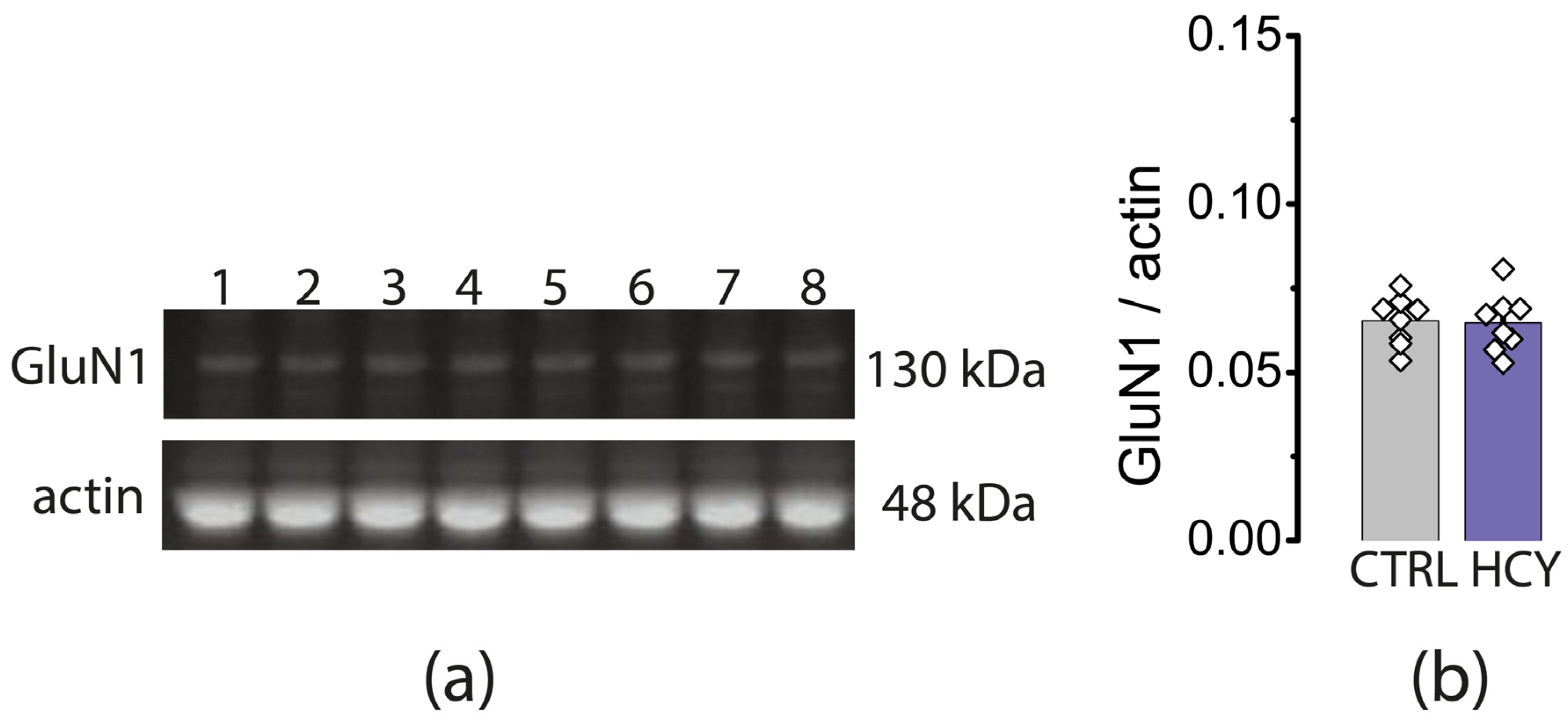
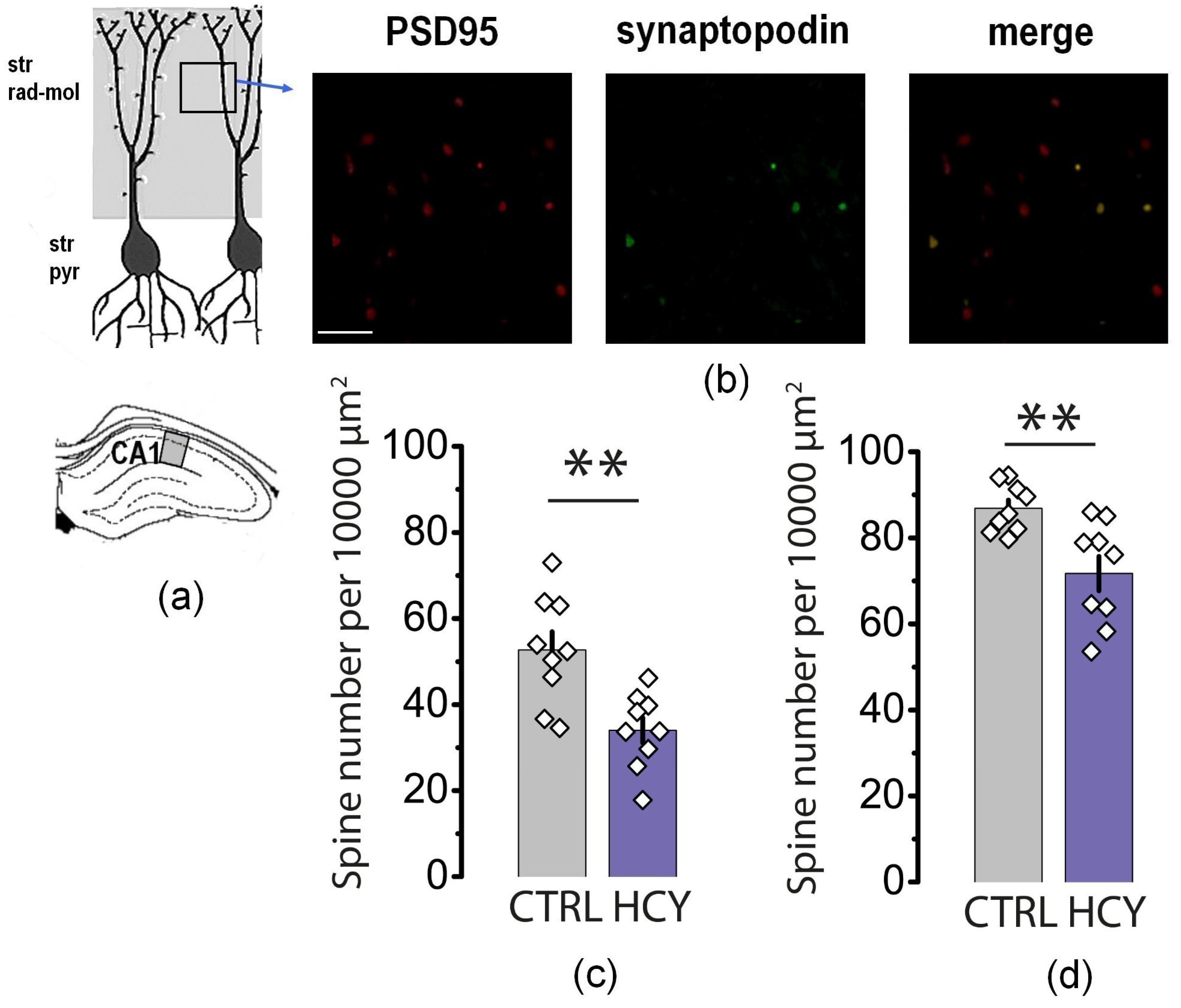
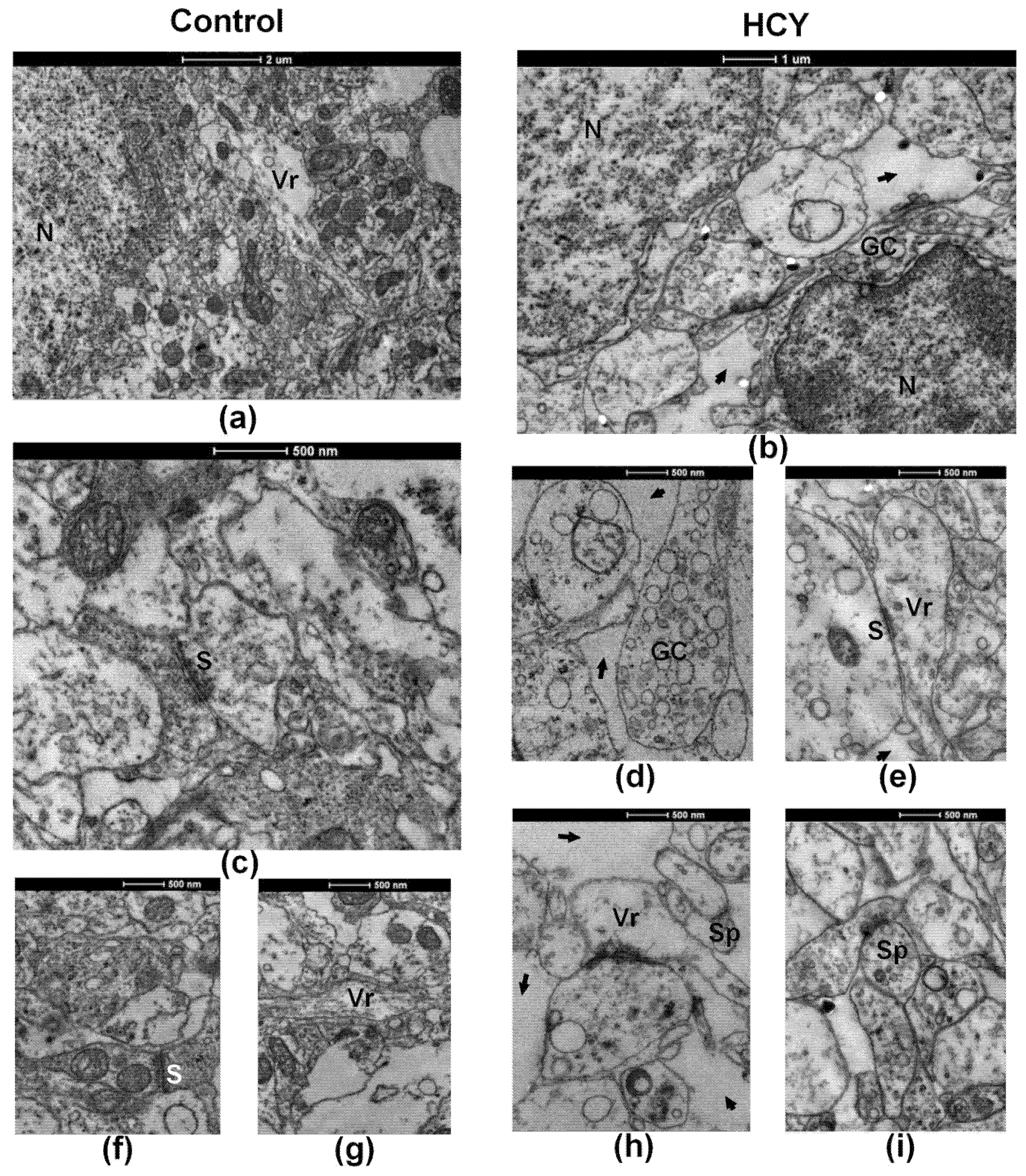
| Groups | Electro-Physiology | RT-qPCR | WB | IHC | EM | Behavioral Tests | |
|---|---|---|---|---|---|---|---|
| NOR | MWM | ||||||
| P20 CTRL | 13 | 7 | 8 | 9 | 3 | 12 | 8 |
| P20 HCY | 14 | 8 | 8 | 9 | 3 | 12 | 11 |
| P90 CTRL | - | 6 | - | 9 | 3 | 10 | 8 |
| P90 HCY | - | 8 | - | 9 | 3 | 10 | 10 |
Disclaimer/Publisher’s Note: The statements, opinions and data contained in all publications are solely those of the individual author(s) and contributor(s) and not of MDPI and/or the editor(s). MDPI and/or the editor(s) disclaim responsibility for any injury to people or property resulting from any ideas, methods, instructions or products referred to in the content. |
© 2022 by the authors. Licensee MDPI, Basel, Switzerland. This article is an open access article distributed under the terms and conditions of the Creative Commons Attribution (CC BY) license (https://creativecommons.org/licenses/by/4.0/).
Share and Cite
Postnikova, T.Y.; Amakhin, D.V.; Trofimova, A.M.; Tumanova, N.L.; Dubrovskaya, N.M.; Kalinina, D.S.; Kovalenko, A.A.; Shcherbitskaia, A.D.; Vasilev, D.S.; Zaitsev, A.V. Maternal Hyperhomocysteinemia Produces Memory Deficits Associated with Impairment of Long-Term Synaptic Plasticity in Young Rats. Cells 2023, 12, 58. https://doi.org/10.3390/cells12010058
Postnikova TY, Amakhin DV, Trofimova AM, Tumanova NL, Dubrovskaya NM, Kalinina DS, Kovalenko AA, Shcherbitskaia AD, Vasilev DS, Zaitsev AV. Maternal Hyperhomocysteinemia Produces Memory Deficits Associated with Impairment of Long-Term Synaptic Plasticity in Young Rats. Cells. 2023; 12(1):58. https://doi.org/10.3390/cells12010058
Chicago/Turabian StylePostnikova, Tatyana Y., Dmitry V. Amakhin, Alina M. Trofimova, Natalia L. Tumanova, Nadezhda M. Dubrovskaya, Daria S. Kalinina, Anna A. Kovalenko, Anastasiia D. Shcherbitskaia, Dmitry S. Vasilev, and Aleksey V. Zaitsev. 2023. "Maternal Hyperhomocysteinemia Produces Memory Deficits Associated with Impairment of Long-Term Synaptic Plasticity in Young Rats" Cells 12, no. 1: 58. https://doi.org/10.3390/cells12010058
APA StylePostnikova, T. Y., Amakhin, D. V., Trofimova, A. M., Tumanova, N. L., Dubrovskaya, N. M., Kalinina, D. S., Kovalenko, A. A., Shcherbitskaia, A. D., Vasilev, D. S., & Zaitsev, A. V. (2023). Maternal Hyperhomocysteinemia Produces Memory Deficits Associated with Impairment of Long-Term Synaptic Plasticity in Young Rats. Cells, 12(1), 58. https://doi.org/10.3390/cells12010058





